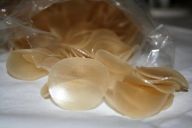Twee keer zo groot
In het Chinees heet kroepoek xiabing 虾饼, wat letterlijk vertaald kan worden als "garnalenkoekje". Deze kroepoek is een gefrituurde snack gemaakt van zetmeel en garnalen. De Nederlandse kroepoek in Chinees-Indische restaurants wordt vaak gekocht in een kleine, harde en droge vorm, van ongeveer 19 cm bij 5 cm. Wanneer de kroepoek in hete olie wordt gelegd, zet hij uit en wordt hij groot en knapperig.
Volgens de beroemde chef-kok en street food expert Will Meyrick gaat de legende dat de eerste kroepoek werd ontwikkeld door het pletten van garnalenkoppen.[2] Oorspronkelijk in Indonesië wordt deze knapperige snack vaak gemaakt van een mengsel van tapioca zetmeel, water, en garnalen. Dit mengsel wordt tot een deeg gemaakt en vervolgens gestoomd. Na het stomen kan het in dunne plakjes worden gesneden en vervolgens worden gedroogd. Naast snack wordt krupuk, of de kleinere variant genaamd kripik in het Bahasa Indonesisch, vaak gebruikt als aanvulling op een gerecht. In Indonesië, bijvoorbeeld, kunnen we veel verschillende soorten krupuk vinden in verschillende regio's. Krupuk udang, wat vertaald kan worden als garnalenkroepoek, lijkt het meest op de kroepoek die door Chinees-Indonesische restaurants in Nederland wordt verkocht.

